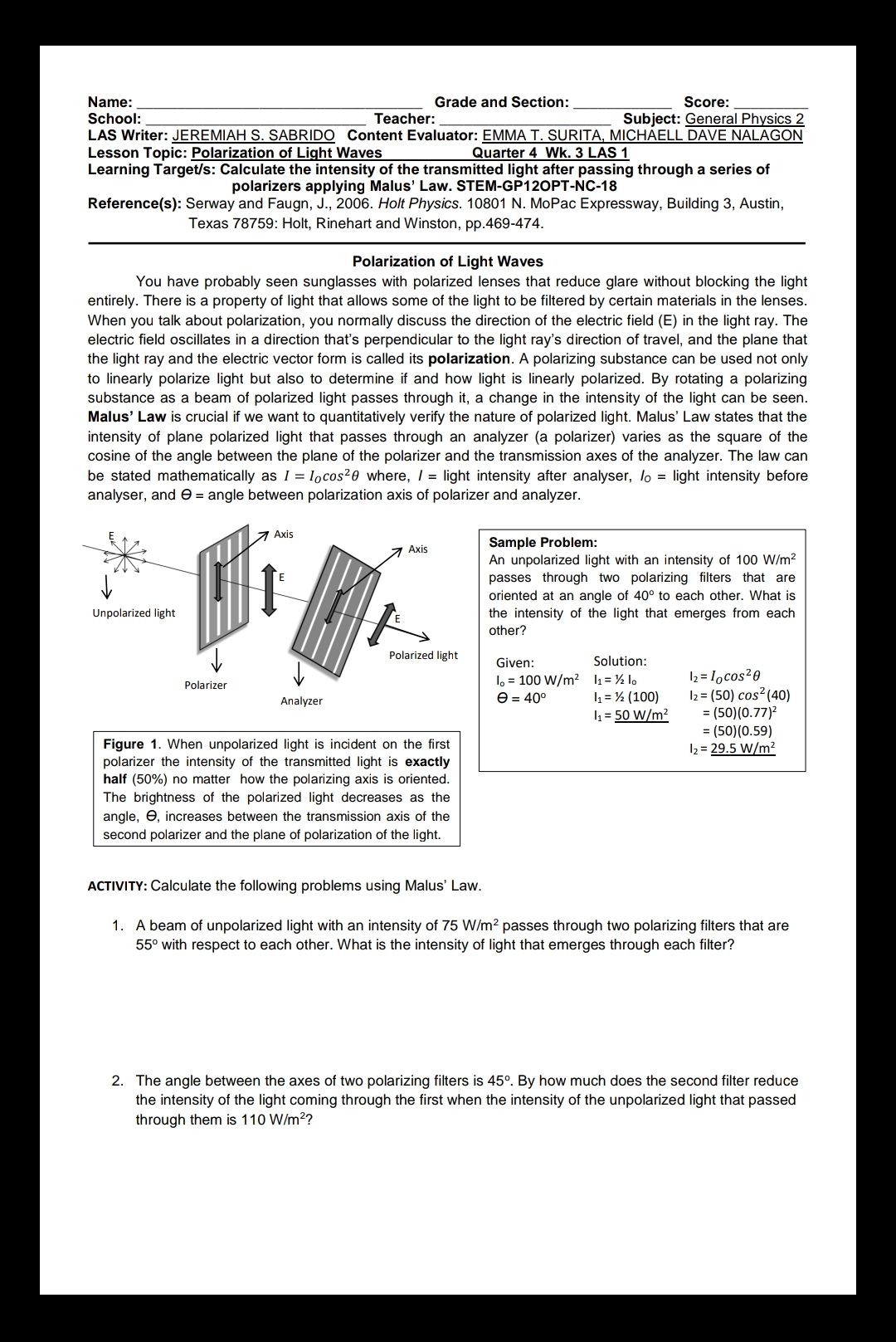polarization of light waves
Name: Grade and Section: Score: School: Teacher: Subject: General Physics 2 LAS Writer: JEREMIAH S. SABRIDO Content Evaluator: EMMA T. SURITA MICHAELL DAVE NALAGON Lesson Topic: Polarization of Light Waves Quarter 4 Wk. 3 LAS 1 Learning Targetls: Calculate the Intensity of the transmitted light after passing through a series of polarizers applying Malus' Law. STEM-GP120PT-Nc-18 Reference(s): Senivay and Faugn, J., 2006. Hoff Physics. 10801 N. MoPac Expressway, Building 3, Austin, Texas 78T59: Holt, Rinehart and Winston, pp.469-474. Polarization of Light Waves You have probably seen sunglasses with polarized lenses that reduce glare without blocking the light entirely. There is a property of light that allows some of the light to be filtered by certain materials in the lenses. When you talk about polarization, you normally discuss the direction of the electric field (E) in the light ray. The electric eld oscillates in a direction that's perpendicular to the light ray's direction of travel, and the plane that the light ray and the electric vector form is called its polarization. A polarizing substance can be used not only to linearly polarize light but also to determine if and how light is linearly polarized. By rotating a polarizing substance as a beam of polarized light passes through it, a change in the intensity of the light can be seen. Malus' Law is crucial if we want to quantitatively verify the nature of polarized light. Malus' Law states that the intensity of plane polarized light that passes through an analyzer (a polarizer) varies as the square of the cosine of the angle between the plane of the polarizer and the transmission axes of the analyzer. The law can be stated mathematically as I = 10:03sz where, f: light intensity after analyser, to = light intensity before analyser, and 8 = angle between polarization axis of polarizer and analyzer. Sample Problem: Ah unpolarized light with an intensity of 100 mez \\14 passes through two polarizing lters that are oriented at an angle of 40\" to each other. What is Unpolarizedtighr the intensity of the light that emerges from each other? 'L Polarized light Given: Solution: \\l/ I, = 100 w/rnz I1 = y. u '2 = 1060523 Analyze, e = 400 i1 = a [100} I2 = {50} 6052(40) l1: 50w m2 = [SOHO-Ni\" = [50}[0.59] Figure 1. When unpolarized light is incident on the rst |2=29_5 mez polarizer the intensity of the transmitted light is exactly half (50%] no matter how the polarizing axis is oriented. The brightness of the polarized light decreases as the angle, 9, increases between the transmission axis of the second polarizer and the plane of polarization of the light. Polarizer ACTIVITY: Calculate the following problems using Malus' Law. 1. A beam of unpolarized light with an intensity of 75 Wl'm2 passes through two polarizing filters that are 55 with respect to each other. What is the intensity of light that emerges through each filter? . The angle between the axes of two polarizing filters is 45\". By how much does the second filter reduce the intensity of the light coming through the first when the intensity of the unpolarized light that passed through them is 1 10 mez







